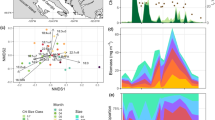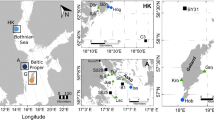Abstract
The spring zooplankton community in the Strait of Georgia (British Columbia, Canada) is characterized by the presence of several calanoid copepod species which collectively make up ~90% of the mezozooplankton biomass. Here, we investigate interspecific, interannual, and geographic variability in the diets and trophic positions of these copepods using a combination of fatty acids and stable isotopes. To characterize geographic variability in diet, we compare our findings from the Strait of Georgia with similar data from Ocean Station P in the subarctic northeast Pacific. Both fatty acid and stable isotope signatures indicate the existence of three trophic levels, even within the limited size range of these copepods: Neocalanus plumchrus and Calanus marshallae are primarily omnivorous, while Euchaeta elongata is carnivorous and Eucalanus bungii is herbivorous. Fatty acid markers of trophic position (e.g., DHA/EPA, 18:1n-9/18:1n-7) correlate significantly with δ15N, while markers indicating the proportion of diatoms to flagellates in the diet (e.g., 16PUFA/18PUFA and DHA/EPA) correlate significantly with δ13C, after the effect of lipid concentration on δ13C is accounted for. Despite the general correlation between stable isotopes and fatty acids, the former are not sensitive enough to capture the range of interannual variability observed in the latter, and can only capture substantial shifts in the diet over geographic scales. However, regardless of variability in food quality, the relative trophic positions of these copepods do not change significantly either spatially or temporally.





Similar content being viewed by others
References
Ackman RJ (1986) Capillary gas–liquid chromatography. In: Hamilton RJ, Rossell JB (eds) Analysis of oils and fats. Elsevier, London, pp 137–206
Alfaro AC, Thomas F, Sergent L, Duxbury M (2006) Identification of trophic interactions within an estuarine food web (northern New Zealand) using fatty acid biomarkers and stable isotopes. Estuar Coast Shel Sci 70:271–286
Atkinson A (1995) Omnivory and feeding selectivity in 5 copepod species during spring in the Bellingshausen sea, Antarctica. ICES J Mar Sci 52:385–396
Bray JR, Curtis JT (1957) An ordination of the upland forest communities of Southern Wisconsin. Ecol Mongr 27:325–349
Budge SM, Parrish CC (1998) Lipid biogeochemistry of plankton, settling matter and sediments in Trinity Bay, Newfoundland. II. Fatty acids. Org Geochem 29:1547–1559
Campbell RW, Boutillier P, Dower JF (2004) Ecophysiology of overwintering in the copepod Neocalanus plumchrus: changes in lipid and protein contents over a seasonal cycle. Mar Ecol Prog Ser 280:211–226
Clarke KR (1993) Nonparametric multivariate analyses of changes in community structure. Aust J Ecol 18:117–143
Cripps GC, Atkinson A (2000) Fatty acid composition as an indicator of carnivory in Antarctic krill, Euphausia superba. Can J Fish Aquat Sci 57:31–37
Dalsgaard J, St John M, Kattner G, Müller-Navarra D, Hagen W (2003) Fatty acid trophic markers in the pelagic marine environment. Adv Mar Biol 46:225–340
El-Sabaawi RW, Dower JF, Kainz M, Mazumder A (2008) Interannual variability in the fatty acid composition of the copepod Neocalanus plumchrus (Murakawa) in the Strait of Georgia, British Columbia, Canada. Accepted for publication in Marine Ecology Progress Series
Evanson M, Bornhold MA, Goldblatt RH, Harrison PJ, Lewis AG (2000) Temporal variability in body composition and lipid storage of the overwintering, subarctic copepod, Neocalanus plumchrus in the Strait of Georgia, British Columbia (Canada). Mar Ecol Porg Ser 192:239–247
Fry B, Wainright SC (1991) Diatom sources of C-13 rich carbon in marine food webs. Mar Ecol Prog Ser 76:149–157
Gifford DJ, Dagg MJ (1988) Feeding on the estuarine copepod Acartia tonsa dana—carnivory versus herbivory in natural microplankton assemblages. B Mar Sci 43:458–468
Graeve M, Hagen W, Kattner G (1994) Herbivorous or omnivorous? On the significance of lipid compositions as trophic markers in Antarcitc copepods. Deep Dea Res Pt I 41:915–924
Graeve M, Albers C, Kattner G (2005) Assimilation and biosynthesis of lipids in Arctic Calanus species based on feeding experiments with a C-13 labelled diatom. J Exp Mar Biol Ecol 317:109–125
Hagen W, Kattner G, Graeve M (1995) On the lipid biochemistry of polar copepods—compositional differences in the Antarctic calanoid Euchaeta antarctica and Euchirella rostromagna. Mar Biol 123:451–457
Hagen W, Yoshida T, Virtue P, Kawaguchi S, Swadling KM, Nicol S, Nichols PD (2007) Effect of a carnivorous diet on the lipids, fatty acids and condition of Antarctic krill, Euphausia superba. Antarct Sci 19:183–188
Hairston NG, Hairston NG (1993) Cause–effect relationships in the energy flows, trophic structure and interspecific interactions. Am Nat 142:379–411
Harrison PJ, Fulton JD, Taylor FJR, Parsons TR (1983) Review of the biological oceanography in the Strait of Georgia: pelagic environment. Can J Fish Aquat Sci 40:1064–1094
Harrison PJ, Whitney FA, Tsuda A, Saito H, Tadokoro K (2004) Nutrient and plankton dynamics in the NE and NW gyres of the subarctic Pacific Ocean. J Oceanogr 60:93–117
Jiang HS, Osborn TR (2004) Hydrodynamics of copepods: a review. Surv Geophys 25:339–370
Johannessen SC, O’Brien MC, Denman KL, Macdonald RW (2005) Seasonal and spatial variations in the source and transport of sinking particles in the Strait of Georgia, British Columbia, Canada. Mar Geol 216:59–77
Kainz M, Arts MT, Mazumder A (2004) Essential fatty acids in the planktonic food web and their ecological role for higher trophic levels. Limnol Oceanogr 49:1784–1793
Kaneda T (1991) Iso-fatty acid and anteiso-fatty acids in bacteria—biosynthesis function and taxonomic significance. Microbiol Rev 55:288–302
Kleppel GS (1993) On the diets of calanoid copepods. Mar Ecol Prog Ser 99(1–2):183–195
Krause EP, Lewis AG (1979) Ontogenetic migration and the distribution of Eucalanus bungii (copepoda, calanoida) in British Columbia inlets. Can J Zool 57:2211–2222
Landry MR (1981) Witching between herbivory and carnivory by the planktonic marine copepod Calanus pacificus. Mar Biol 65(1):1432–1793
Landry MR (2007) From primary production to mesozooplankton: trophic transfers through microbial food webs. PICES 4th international zooplankton meeting, Hiroshima, Japan (abstract)
Lee RF (1974) Lipids of zooplankton from Bute Inlet, British Columbia. J Fish Res Brd Can 31:1577–1582
Logan JM, Lutcavage ME (2008) A comparison of carbon and nitrogen stable isotope ratios of fish tissues following lipid extractions with non-polar and traditional chloroform/methanol solvent systems. Rapid Commun Mass Spec 22(7):1081–1086
Logan JM, Jardine TD, Miller TJ (2008) Lipid corrections in carbon and nitrogen stable isotope analyses: comparison of chemical extraction and modelling methods. J Anim Ecol 77(4):838–846
Mauchline J (1998) The biology of calanoid copepods. Adv Mar Biol 33:1–710
McConnaughey T, McRoy CP (1979) Food-web structure and the fractionation of carbon isotopes in the Bering Sea. Mar Biol 53:257–262
Michels J, Schnack-Schiel SB (2005) Feeding in dominant Antarctic copepods—does the morphology of the mandibular gnathobases relate to diet? Mar Biol 146:483–495
Minagawa M, Wada E (1984) Stepwise enrichment of 15N along food chains: further evidence and the relation between 15N and animal age. Geochim Cosmochim Acta 48:1135–1140
Needoba JA, Marchetti A, Henry MF, Harrison PJ, Wong CS, Johnson WK, Pedersen TF (2006) Stable nitrogen isotope dynamics of a mesoscale iron enrichment experiment in the NE Subarctic Pacific. Deep Sea Res Pt II 53:2214–2230
Nyssen F, Brey T, Dauby P, Graeve M (2005) Trophic position of Antarctic amphipods—enhanced analysis by a 2-dimensional biomarker assay. Mar Ecol Prog Ser 300:135–145
Parrish C (1999) Determination of total lipids, lipid classes and fatty acids in aquatic samples. In: Arts M, Wainmann BC (eds) Lipids in freshwater ecosystems. Springer, New York
Pawlowicz R, Sastri AR, Allen SE, Cassis D, Riche O, Halverson M, Dower J, El-Sabaawi RW (2008) Carbon flow and the plankton ecology of the Strait of Georgia, British Columbia (manuscript in preparation)
Perga ME, Kainz M, Matthews B, Mazumder A (2006) Carbon pathways to zooplankton: insights from the combined use of stable isotope and fatty acid biomarkers. Freshw Biol 51:2041–2051
Post DM (2002) Using stable isotopes to estimate trophic position: models, methods, and assumptions. Ecology 83:703–718
Post DM, Layman CA, Arrington DA, Takimoto G, Quattrochi J, Montana CG (2007) Getting to the fat of the matter: models, methods and assumptions for dealing with lipids in stable isotope analyses. Oecologia 152:179–189
Post DM, Takimoto G (2007) Proximate structural mechanisms for variation in food-chain length. Oikos 116:775–782
Poulet SA, Marsot P (1978) Chemosensory grazing by marine calanoid copepods (arthropoda, crustacea). Science 200:1403–1405
Saito H, Kotani Y (2000) Lipids of four boreal species of calanoid copepods: origin of monoene fats of marine animals at higher trophic levels in the grazing food chain in the subarctic ocean ecosystem. Mar Chem 71:69–82
Sargent JR, Whittle KJ (1981) Lipids and hydrocarbons in marine foodwebs. In: Longhurst AR (ed) Analysis of marine ecosystems. Academic Press, London
Schmidt K, Atkinson A, Petzke KJ, Voss M, Pond DW (2006) Protozoans as a food source for Antarctic krill, Euphausia superba: complementary insights from stomach content, fatty acids, and stable isotopes. Limnol Oceanogr 51:2409–2427
Scott CL, Kwasniewski S, Falk-Petersen S, Sargent JR (2002) Species differences, origins and functions of fatty alcohols and fatty acids in the wax esters and phospholipids of Calanus hyperboreus, C. glacialis and C. finmarchicus from Arctic waters. Mar Ecol Prog Ser 235:127–134
Sommer F, Saage A, Santer B, Hansen T, Sommer U (2005a) Linking foraging strategies of marine calanoid copepods to patterns of nitrogen stable isotope signatures in a mesocosm study. Mar Ecol Prog Ser 286:99–106
Sommer U, Hansen T, Blum O, Holzner N, Vadstein O, Stibor H (2005b) Copepod and microzooplankton grazing in mesocosms fertilised with different Si:N ratios: no overlap between food spectra and Si:N influence on zooplankton trophic level. Oecologia 142:274–283
Sprules WG, Bowerman JE (1988) Omnivory and foodchain length in zooplankton foodwebs. Ecology 69:418–426
Stevens CJ, Deibel D, Parrish CC (2004a) Copepod omnivory in the North Water Polynya (Baffin Bay) during autumn: spatial patterns in lipid composition. Deep Sea Res Pt I 51:1637–1658
Stevens CJ, Deibel D, Parrish CC (2004b) Incorporation of bacterial fatty acids and changes in a wax ester-based omnivory index during a long-term incubation experiment with Calanus glacialis Jaschnov. J Exp Mar Biol Ecol 303:135–156
Stevens CJ, Deibel D, Parrish CC (2004c) Species-specific differences in lipid composition and omnivory indices in Arctic copepods collected in deep water during autumn (North Water Polynya). Mar Biol 144:905–915
Stibor H, Vadstein O, Diehl S, Gelzleichter A, Hansen T, Hantzsche F, Katechakis A, Lippert B, Loseth K, Peters C, Roederer W, Sandow M, Sundt-Hansen L, Olsen Y (2004) Copepods act as a switch between alternative trophic cascades in marine pelagic food webs. Ecol Lett 7:321–328
St John MA, Clemmesen C, Lund T, Koster T (2001) Diatom production in the marine environment: implications for larval fish growth and condition. ICES J Mar Sci 58:1106–1113
Stockner JG, Cliff DD, Shortreed KRS (1979) Phytoplankton ecology of the Strait of Georgia, British Columbia. J Fish Res Brd Can 36:657–666
Veefkind R (2003) Carbon isotope ratios and composition of fatty acids: tags and trophic markers in pelagic organisms. Dissertation, The University of Victoria, Victoria, British Columbia, Canada
Viso AC, Marty JC (1993) Fatty acids from 28 marine microalgae. Phytochemistry 34:1521–1533
Zar JH (1984) Biostatistical analysis. Prentice Hall, Englewood Cliffs
Acknowledgments
The authors would like to thank the captains and crew of the R/V John Strickland (University of Victoria) and CGGS Siyay for the assistance with sampling. Chris Parrish, Sergei Verenitch and Kelly Young provided valuable technical advice for instrumentation, extraction and fatty acid identification. This research was supported by an NSERC Discovery Grant to John F. Dower and Asit Mazumder, an NSERC Strategic Grant to Susan Allen. Rana El-Sabaawi received funding from NSERC and The University of Victoria. The authors would like to thank three anonymous reviewers whose comments greatly improved this manuscript.
Author information
Authors and Affiliations
Corresponding author
Additional information
Communicated by U. Sommer.
Rights and permissions
About this article
Cite this article
El-Sabaawi, R., Dower, J.F., Kainz, M. et al. Characterizing dietary variability and trophic positions of coastal calanoid copepods: insight from stable isotopes and fatty acids. Mar Biol 156, 225–237 (2009). https://doi.org/10.1007/s00227-008-1073-1
Received:
Accepted:
Published:
Issue Date:
DOI: https://doi.org/10.1007/s00227-008-1073-1




